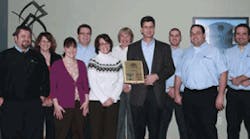When Brian Wagner, president of CCG Energy Solutions in Richfield, Ohio, got the green light to retrofit the Mt. Vernon (Ohio) Middle School, the building had an EPA Energy Star rating of 1. This month Wagner will deliver the new Energy Star plaque to the school, showing an Energy Star rating of 94 out of 100. Because of the outstanding work performed by Wagner and his team, CCG Energy Solutions won First Prize in the Commercial Building Category in CONTRACTOR's Green Mechanical Contractor magazine Green Mechanical Awards.
Mt. Vernon Middle School struggled with comfort problems from the time it opened in 1997. Some contractors say they avoid the K-12 market because it's fraught with problems, and this structure is a good example why. So many components of the mechanical system did not work that it makes you scratch your head. It certainly doesn't speak well for the low-bid method of purchasing construction. It was, Wagner says, “a terrible combination of little things that added up.”
The result of CCG Energy Solutions work is stunning.
One year following the completion of this project, Mount Vernon Middle School is operating at an incredible 37,800 Btu/sq.ft. and an associated $.68/sq.ft. This project has reduced a significant amount of pollutants from being emitted into the environment, equivalent to the removal of 255 cars from the roadways.
The project was estimated to save 1,629-mcf of gas and 546,693 kWh of electricity. After one year, the gas savings was 5,964-mcf and the electric savings was 2,327,574 kWh from their adjusted baseline. The project exceeded its projected savings by $175,885. The system, which was originally calculated to pay for itself in 10.92 years, will have a 4.01-year payback based on the first year reconciliation.
Wagner and his people had been providing small control upgrades in the building.
“We had been doing some work,” Wagner says, “but it was not all-encompassing. We had been putting Band-Aids on, if you will. This is pretty common; we see similar issues in many newer buildings that either have design issues or installation issues. We have completed six projects similar to this already and are looking at several more currently.”
In addition to comfort issues, the building experienced high operating costs and high repair costs. For the last three years before the project was completed, they averaged $45,000 a year on compressor repair and replacement. There were teacher complaints, student complaints, areas of the building that were too hot or too cold, and moisture problems.
Finally, all the stars aligned. The district's administration had been considering a retrofit project for quite a while. Ohio law allows schools to take the Request for Qualifications route (known as a House Bill 264 Energy Conservation Program) and select a performance contractor based on an interview process because the work is paid for with the savings. And the district administration looked at the service bills and said enough was enough.
Wagner was familiar with some of the complaints because of the control work he was doing, but he didn't know the details until his firm did its survey.
They were having multiple compressor failures because of the way the ice storage was piped. The ice storage system never worked properly. It wasn't sized for the available time they had to make ice and the school did not have a favorable time-of-day rate from the electric utility. Because of capacity problems with the chillers and compressor lockouts, the school's maintenance staff isolated the ice storage system and stopped using it within months of installation.
The valving didn't work. The controls didn't work.
Chilled water was piped to the hot water coils and hot water was going to the chilled water coils. The coils are, by design, sized differently. Controls called for heating and there was no hot water in the coil. Two or three of the air handlers suffered from this backwards piping and this was never caught from Day One.
The automatic valves would not stroke and the maintenance crew could not get the controls to control them properly.
“The maintenance people tried and they were pulling their hair out,” Wagner says. “They couldn't get the right contractor in to fix the problems. It was pretty overwhelming to the district.”
The actuators were not functioning properly on the air handlers and they couldn't modulate the heat on the VAV boxes. The majority of the actuators on the reheat valves were burnt out. Literally. The reheat actuators were pulse actuators, but the control system was so out of calibration that it was constantly driving them open and closed. The installed actuators could not handle the heat. When Wagner's people removed them, they were blackened.
The sensors were not in the right places in the ductwork, so they weren't getting good readings. Wires were crossed. Various control system components were not connected. The district couldn't get support for the old control system, so for the last six years there was virtually no service on it. It suffered not only from hardware problems, but software problems made changes such as set points and scheduling problematic.
CCG Energy Solutions was the right company to fix all of that.
The redesign of the heating system included upgrading two constant-flow 6 million Btuh input, hot water boilers with a variable-primary system with two high-efficiency 2 million Btuh input condensing boilers. These upgrades also included the installation of variable frequency drives on the hot water pumps and replacement of three-way heating valves with two-way valves. The redesign of the chilled water system replaced the existing primary/secondary system, including two air-cooled chillers, ice storage tanks, and water-to-water heat exchanger, with a variable-primary system.
The existing building automation system was upgraded to an Automated Logic WebCTRL system.
The building-wide lighting upgrade included new technology lighting to include multi-level lighting and dimming lighting. Rooms with low foot-candle readings as well as rooms with high foot-candle readings were brought up to current standards.
The building had been cooled by two 155-ton air-cooled chillers with ice storage and a heat exchanger. The system had been bypassed for nearly its entire life.
The boilers were so grossly oversized and mismatched with their pumps that it was a common occurrence for the relief valves to open and drain the water from the system, along with its chemicals, due to the overheating of the water. The mechanical equipment was right-sized in the redesign. The two 6 million Btuh boilers were removed and replaced with two 2 million Btuh Aerco Benchmark boilers. New ABB variable frequency drives were installed on the existing pumps.
Many other miscellaneous items were addressed. The majority of the three-way heating and cooling valves were replaced with two-way valves. Piping to coils in air handlers was corrected. Control of all exhaust fans was added to the building automation system.
Now building systems are working together, the humidity issues have been resolved and the temperature is being controlled to within +/- 1/10th of 1°F from set point. With properly installed mechanical systems in place, not only is there reduced energy use, but also less employee time needed for troubleshooting and equipment repairs.
The school board was a forward-looking employer, Wagner says.
“They were looking for a proactive way to fix the problems and the energy would pay for it,” Wagner says. “The administration and board were very good to work with. We gave them a whole shopping list of things that they could do like water conservation that they chose not to do right now because of their focus on comfort issues. It was a very good experience.
“They were really floored [by the amount of savings],” Wagner continued, “and so were we. We didn't realize that a lot of things we found we didn't uncover in the audit. We're very conservative in our calculations, but we didn't expect them to be like they were. When you add all this up, it has a big impact. This is a 136,000-sq.ft. building that's spending approximately $20,000 a year on gas.”
CCG Energy Solutions is a performance contracting company that helps organizations improve their indoor environments — temperature, humidity, indoor air quality, light and other factors that consume energy and affect productivity.
This Mt. Vernon Middle School project is a great example of the impact of properly designed and installed mechanical systems on energy consumption, operation costs, equipment life — and most importantly, occupant comfort.
The energy conservation measures implemented in this project have made it a total green mechanical success in comfort, energy usage and improving indoor air quality. The school is taking the first step towards the reduction of greenhouse gas emissions for their community, paving the way as green stewards.






